

Resplendent royal blue sapphires from Kashmir, gorgeous green emeralds from Colombia, and vivid pigeon blood-red rubies from Burma. These gems have been coveted throughout the ages and have graced some of the most magnificent jewelry the world has known. But there is another beauty, one of earth’s offerings that presents all these colors and more—the glorious garnet. This unsung gem has made its colorful mark for thousands of years.

Archeologists have recovered garnet necklaces and talismans from ancient Egyptian tombs and mummies. The ancient Greeks and Romans used them as seals on signet rings to seal important documents as well as for jewelry.

Roman scholar Pliny the Elder called the finest red gemstones (almandine garnets, rubies, and spinel), with a “brilliancy like fire,” carbuncles. During the 19th century, the term came to refer to cabochon-cut red gems, most commonly almandine garnets. No longer used as a professional term by gemologists, you might occasionally encounter these garnets in antique jewelry described as carbuncles.

As with other gems, garnets have a fascinating lore. Jewish tradition holds that Noah brought a garnet onto the ark to guide his way through the dark. The Greek goddess Persephone became Queen of the Underworld when Hades abducted her and took her as his wife. Her mother and father, Demeter and Zeus, made a strong case for her return. Hades obliged but first fed her a pomegranate, which relegated her to live six months in the underworld and six months above ground. It is said that in her sorrow, she shed tears of garnet. In the realm of actual royalty, garnets symbolized power, divine favor, and wealth. Mines located in what is now the present-day Czech Republic supplied fiery Bohemian garnets to European royalty for centuries.

And, at a very merry party somewhere in the 21st century, there is a 16-year-old girl who just received her first “real” jewelry—a pair of garnet earrings to celebrate her January birthday. If you have not given this wondrous stone the full attention that it deserves, take a moment to read further; you’ll discover a historically fascinating gem, complex in composition and captivating in its array of colors.

SO MISUNDERSTOOD
Red. Dull red. Common and unremarkable. Perhaps that’s what comes to mind when someone mentions garnets and, unlike the birthday girl mentioned above, you are less than thrilled that your January birthday is marked by such a stone and bemoan the fact that you were not born in April (in which case you could claim the dazzling diamond as your birthstone). Garnets are far from dull or unremarkable.
Cut open a pomegranate and you’ll see why “granatas,” Latin for “seed,” is the origin of the name “garnet:” the red version of the stone resembles the vivid, juicy seeds of the fruit.
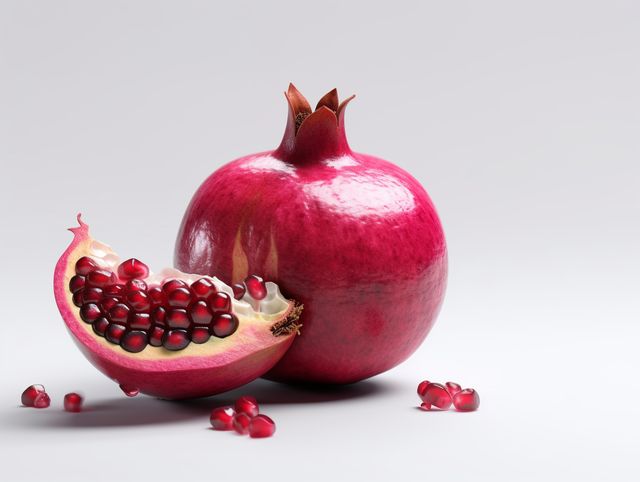


However, garnets belong to a diverse silicate mineral group with a common cubic structure and intermingling chemical compositions that move them beyond the realm of red. This variation in composition gives the garnet its arresting red color and a rainbow range of hues. Garnets are closely related to each other, with overlapping properties, but can be separated into six main species or types.
Almandine * Pyrope * Grossular * Spessartine * Andradite * Uvarovite (rare)
Of the many species and varieties of garnets, the following are most used in jewelry and are well known for their remarkable beauty and intriguing characteristics.
ALMANDINE
COLOR ~ Almandine is most frequently mixed with the magnesium-dominant pyrope which produces a rich deep red color, or with manganese-dominant spessartite which creates a more brownish to orangish red hue.
MINED ~ One of the most common garnet species, Almandine can be found, among other locations, in India, Brazil, Sri Lanka, Madagascar, Kenya, Mozambique, Australia, the Solomon Islands, and the United States.

Pliny the Elder, ever the bestower of names, called stones found or worked at Alabanda, a town in Asia Minor, “alabandicus.” Fortunately, the final—and more lyrical—name of “Almandine” was attributed to this enchanting stone, whose rich wine-red color (think of your favorite cabernet) has added vibrant color to the royal regalia and religious artifacts of civilizations throughout the ages, from Ancient Egypt to the Byzantine Empire.


Imagine the excitement of archaeology student Tom Lucking when he uncovered an ancient bowl in 2014 that led to the discovery of an ancient gravesite from the Byzantine era of the Roman Empire. The site, belonging to a woman, contained various pieces of jewelry including what is now known as the Winfarthing pendant (pictured above and named after the English village in which it was found). The pendant, made from sheet gold, is inlaid with cloisonne-set almandine garnets. Coins from the Merovingian Dynasty (a ruling family of Franks from around the mid-5th – mid-7th centuries) also found at the site date the pendant to the 7th century.



Farther down the line of jewelry history, garnets graced many jewels during the Victorian period. Whether used to cover entire pieces, as focal stones, or as accents, the fiery stone—often rose cut—added, at once, brightness and a rich depth of color to 19th-century adornment.
DEMANTOID
COLOR ~ An extremely rare and highly prized gemstone, demantoid is a variety of the andradite species and gets its vibrant lime-green to emerald hue from traces of chromium and ferric iron.
MINED ~ Discovered by mineralogist Nils Gustaf Nordenskiold in Russia’s Ural Mountains in the early 19th century, this was long the only source. Since the 1990s, discoveries have been made in Madagascar, Namibia, Afghanistan, Iran, Mexico, San Benito County, California, the United States, and other locations.

Around 1853, green “pebbles” were found by children along the Bobrovka River in Russia’s Ural Mountains. The stones, initially misidentified as peridot, were later declared by Finnish mineralogist Nils von Nordensheld to be a version of andradite garnet.



The gem is also remarkably brilliant with a dispersion level (the color flashes of light, often called “fire,” that emanate from the stone) higher than that of a diamond. Because of this, they were named “demantoid” from the Danish word “demant,” which means diamond-like. Some of the most coveted demantoids feature distinctive horsetail inclusions composed of byssolite or chrysotile fibers.

Demantoid was a popular gemstone during the Belle Epoque period (1890-1915), especially in Art Nouveau jewelry. Soon, the rare and highly coveted gemstone became a favorite among the well-heeled (Russian Czars among them) and was used by jewelers all over Europe, lending its extraordinary hue to everything from Faberge Imperial Easter eggs to whimsical brooches.

PYROPE
COLOR ~ Pyrope is mixed with the almandine and spessartite species. Its color ranges from purplish red to deep crimson and is attributed to trace amounts of chromium.
MINED ~ Significant pyrope mines were discovered in Bohemia (the Czech Republic) around 1500; the stones mined there are known as Bohemian garnets. Other sources include: South Africa, Madagascar, Myanmar, Mozambique, and the United States (notably in Arizona and New Mexico).

When the light hits a pyrope garnet, its deep red hue displays bright, fiery flashes that enchant the beholder. Befittingly, the stone’s name originates from the Greek word pyropos, which means “fiery-eyed.” Also mined for centuries in the Mogok Valley in Myanmar, pyrope garnet deposits were found in the Bohemian Highlands of the Czech Republic around 1500 and were coveted for their intense color and clarity. Here’s a bit of gemologist insider knowledge: Bohemian garnets can only be classified as such if they have the element chromium as part of their composition.

Extensively used during the Victorian era, pyrope garnets reached their peak of popularity in the late 1800s. Usually rose cut, the garnets used in jewelry design were set closely, creating swaths and clusters of the vivid, glimmering red stone.



Fashioned during the Victorian era and donated to the Smithsonian in 1937, this exquisite hair comb (pictured below) is one of the most famous pieces of adornment featuring pyrope garnets, including a large rose cut at its crest, that hail from the historic mines in Bohemia. Stunning in its design, the comb is evocative of a crown—on fire.

TSAVORITE
COLOR ~ Tsavorite is the emerald-green variety of grossular garnet, its vibrant color comes from the presence of vanadium and chromium.
MINED ~ Tsavorites are mined in Tanzania, Kenya, and Madagascar. Small deposits also occur in Pakistan and Queen Maud Land, Antarctica.

Leave it to the 1960s to reveal something groovy and green. In 1967, a garnet with an intensely vibrant green color was found in Tanzania by gem prospector and geologist, Campbell R. Bridges. The Tanzanian government would not permit mining, so Bridges continued to search for other sources, figuring more stones might be nearby. In 1971, he discovered garnets on neighboring Kenyan territory near Tsavo National Park. In 1974, Tiffany & Co. launched a marketing campaign that introduced the gem to the public, and the stone was named Tsavorite by Tiffany’s president, Henry Platt, in recognition of the park in which it was found.


Just as in nature, the green color of these rare garnets symbolizes growth and renewal. Their exceptional brilliance along with a very low, if any, presence of inclusions, make tsavorites highly desirable gems for high-end jewelry.

In 2017, many years after Campbell Bridges’s death, an extraordinary 238-carat tsavorite was found in Merelani, a northern area of Tanzania. The crystal was cut by world-renowned gem cutter Victor Tuzlukov into the largest precision-cut tsavorite in the world. The stone, known as the Lion of Merelani, is a 116.76 square cushion cut and is on display at the Smithsonian’s National Gem Collection. In an act that honored his father’s passion for tsavorites, Bruce Bridges, the CEO of the Bridges Tsavorite mining company, recorded the cutting of the Lion of Merelani from start to finish and gifted a version to the Smithsonian.


SPESSARTINE
COLOR ~ Bright orange to reddish brown. Spessartine belongs to the grossular species, is mixed with almandine, and is colored by varying amounts of manganese (more orange in color) and almandine (redder stones)
MINED ~ Spessartine garnet deposits are found in Namibia (mines are now closed), Nigeria, Tanzania, Burma (Myanmar), Brazil, China, Kenya, Madagascar, Sri Lanka (Ceylon), Zambia, and the United States (San Diego County, Nevada, New Mexico, and North Carolina).
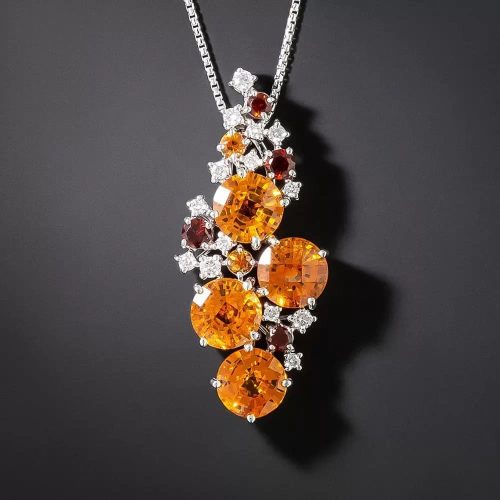
Pluck the orange out of a glorious sunset, put it in a stone and you would get something very close to the riotously vibrant color of a spessartine garnet. The electric gem gets its name from the Bavarian word “Spessart,” meaning “forest,” which is a mountain range in Germany where garnet deposits were found in the 1880s.
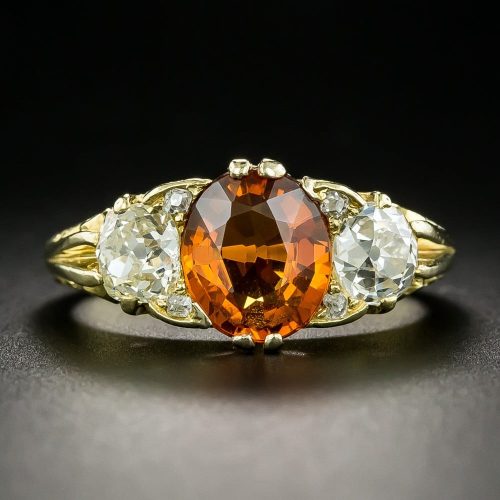

Though all spessartine garnets exhibit some range of orange color, befittingly, those with the purest and most vibrant hue, due to their high manganese content, are called mandarin, like the orange. It is common to hear “mandarin” applied to any spessartine garnet with a vivid orange hue. These stunning stones were discovered in Namibia in the 1990s, and stones with a similar color were discovered in Nigeria in 1998. Later, in 2007, high gem quality garnets very similar to Namibian stones were found in Tanzania. Their color was so vibrant they were called “Fanta” garnets after the equally vibrant orange soda.

With a glow like that of fiery embers, spessartine garnets, especially at larger sizes, lend an exotic and intriguing “what is that?” beauty when featured prominently in lieu of more commonly seen gems. In 2017, Cartier introduced its L’Odyssee de Cartier Parcours d’un Style. Inspired by an imaginary journey through Old World Africa and Asia, the line is lush with pieces that shimmer with diamonds and shine with gorgeous gemstones, including the enthralling spessartine garnet.

RHODOLITE
COLOR/VARIETY ~ Rhodolite is the trade name for another pyrope/almandine garnet mix. The magnesium-rich pyrope has a deep red color that, combined with the iron-rich dark reddish-brown hue of almandine, gives rhodolite garnets their deep purplish-red to electric pinkish-purple to almost pure purple color.
MINED ~ Rhodolite garnets are mined in Tanzania, Mozambique Sri Lanka, Brazil, Zimbabwe, and the United States (North Carolina).
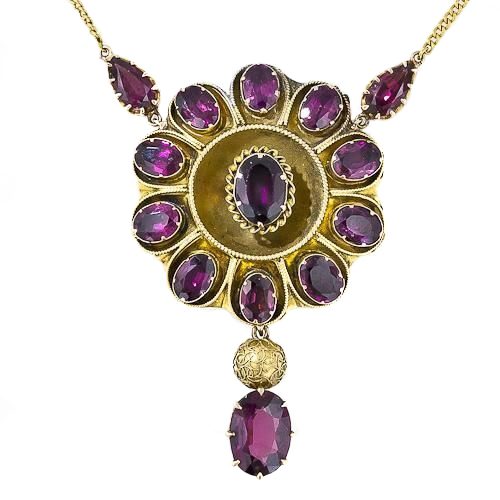
The “rose” of garnets. With its enchanting, vivid purplish-red to reddish-purple color, rhodolite garnets take their name from the Greek word “rhodon,” meaning “rose colored.” Not surprisingly, they symbolize love, passion, and beauty. A relatively modern find, American mineralogist William Earl Hidden first heard about a new garnet in North Carolina, USA from reports by local mineralogist A.M. Field in 1893 and 1897. Analysis confirmed that the stones were a pyrope-almandine hybrid. Tiffany & Co.’s famed gemstone expert, George Kunz, named the stone, describing it as “pale rose-red inclining to purple like that of certain roses and rhododendrons.”


Carl Faberge used color and gemstones lavishly in his unique and extraordinary creations, which were not limited to his stunning eggs. Made around 1900, this Egyptian Revival-style brooch pictured below features a rhodolite garnet carved in the shape of a scarab beetle flanked by enameled lotus blossoms on diamond stems. It is part of the Faberge treasures once owned by the last Russian czar and his family.

FEELING BLUE?
For many years, gemologists and mineralogists believed that the amazing garnet was found in every color except blue. And, although there are no fully blue garnets, color-change stones with a blue component were discovered in the magical land of gemstones, Madagascar, in the 1990s. The extremely rare gems appear blue-green in daylight and purple in incandescent light. Like all other garnets, color-change stones are a species mix, composed predominantly of pyrope and spessartite.
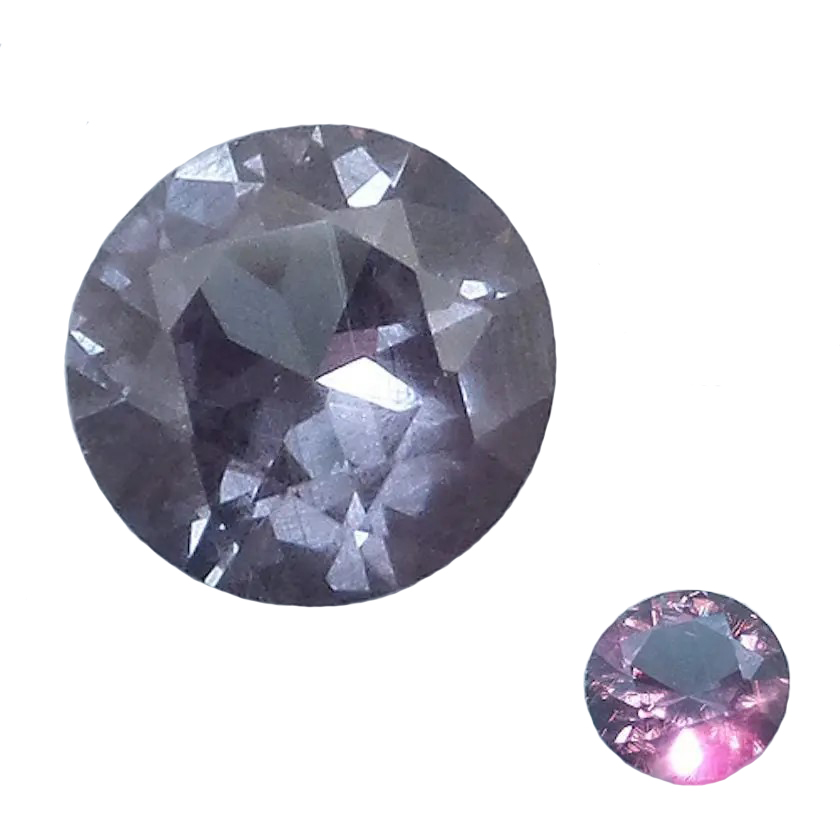
Not to be left out of the rarefied color-change club, some andradite garnets, with their extraordinary “fire” (prismatic light), exhibit color zoning that can present as red/brown, brown/orange/green, and sometimes as red/green.

THE TINIEST MINERS

Mining is serious business, and one group of diminutive miners take it very seriously indeed: red harvester ants. Native to the Southwestern United States, those found in the state of Arizona are a particularly busy bunch and are expert excavators. Fastidious nest-makers, when carving out their tunnels, the industrious ants remove anything blocking the path that is small enough to carry, including garnets (primarily pyropes), which are found in the four-corner states of Arizona, Utah, New Mexico, and Colorado.

Transporting them along with soil and other debris to the ground’s surface, they create ant hills peppered with the vivid red stones. As the rains wash the stones down the sides of the hills, garnet deposits form around the perimeters, where they are collected by those in the know. Discovered long ago by Native Americans, they were used for personal adornment and were incorporated into ceremonial items. Ant hill garnets found in the Navajo Nation can only be collected by members of the Nation. Because of their novel mining method, ant hill garnets have a special appeal for collectors—beauty and a fascinating journey story.
AND SO…



If you were born in January—lucky you! You’ve surely gained a newfound appreciation for your colorful, complex, and captivating birthstone. Not a January baby? How fortuitous that you are now enlightened about one of the earth’s most fascinating gems—it makes our collection all the more wondrous.
Related Reading
Shop at Lang
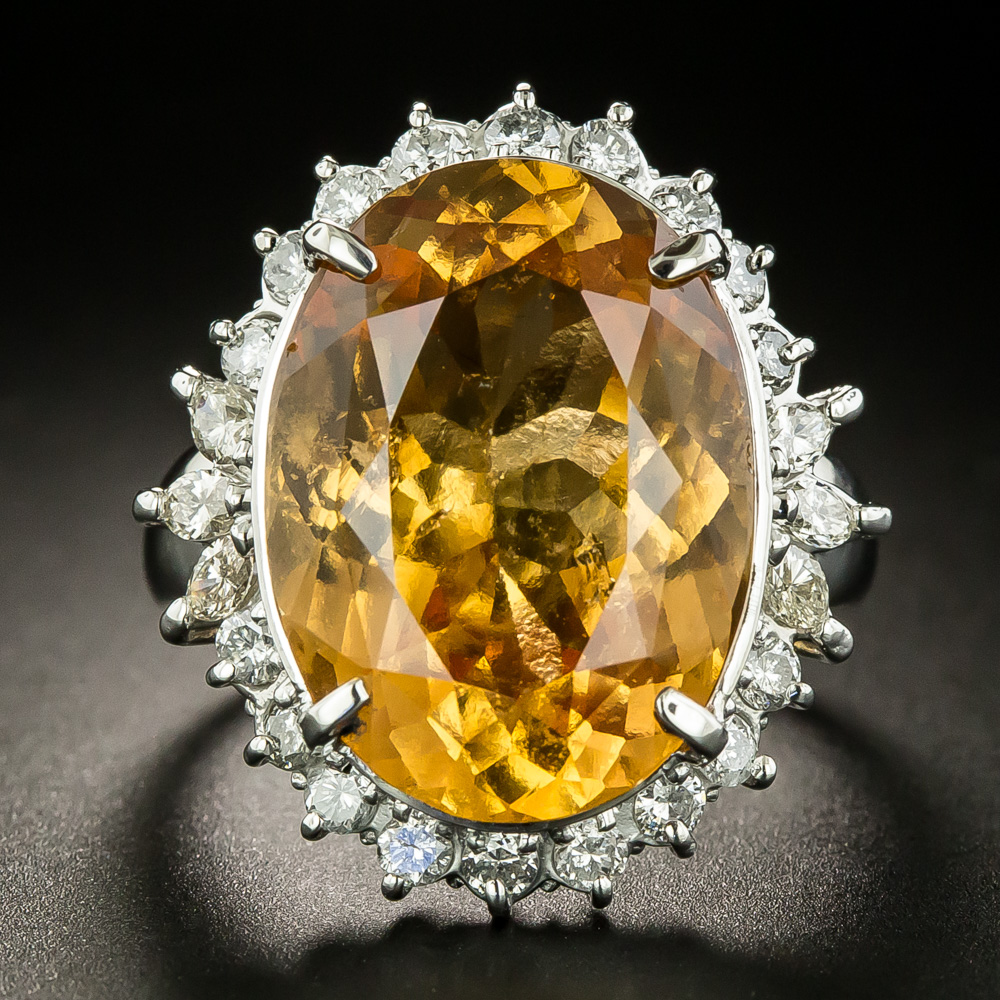
Orange Hessonite Garnet and Diamond Halo Ring
Garnets never cease to amaze; here is yet another outstanding stone. A 16.70-carat hessonite garnet--gleaming and glowing with glorious shades of honey gold and…
SHOP AT LANG
Art Deco Demantoid Garnet and Diamond Ring
This rare and ravishing Jazz Age jewel, dating back to the 1920s, centers on a closely set quartet of lively square cut lime green demantoid garnets, hailing al…
SHOP AT LANG
Victorian 18K Garnet Bracelet
Gorgeous glistening wine-red garnets all around - 5 faceted ovals on top and 3 faceted rounds behind - all of which are are presented in fanciful, rich 18K yell…
SHOP AT LANG
